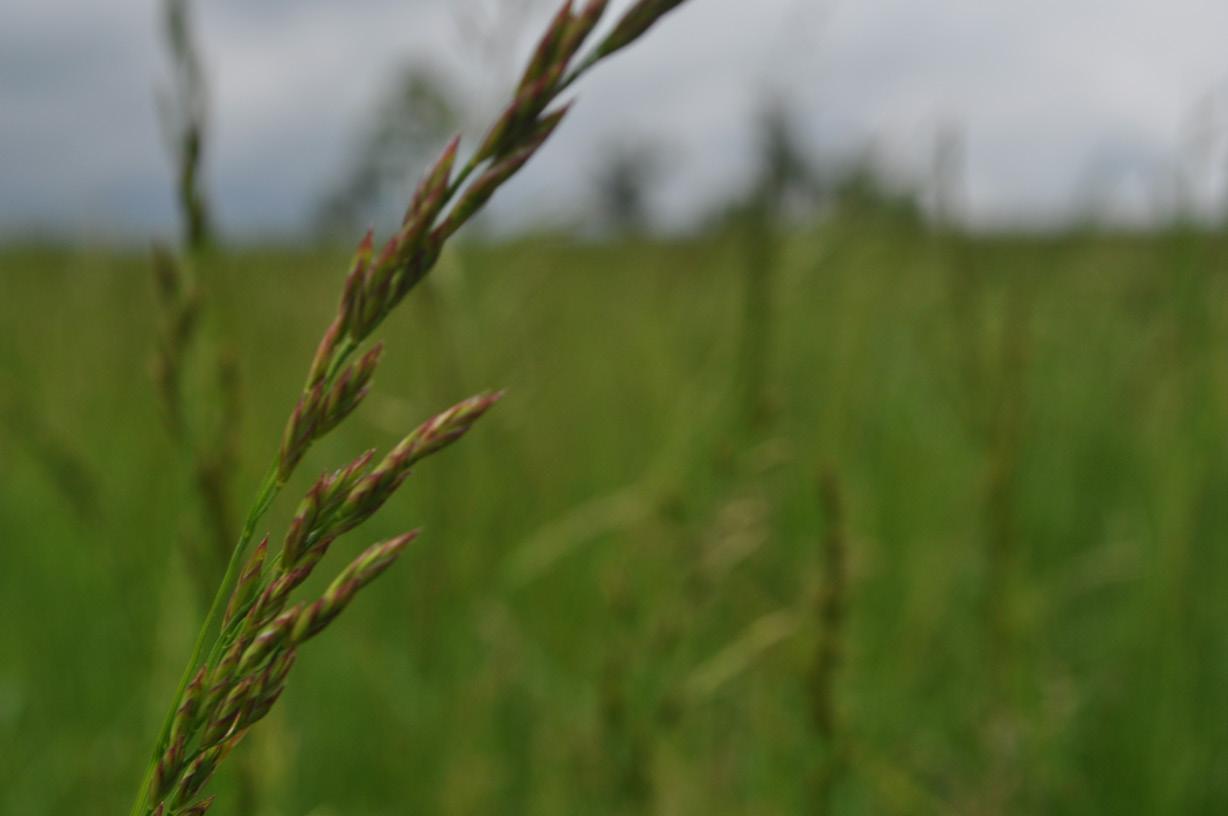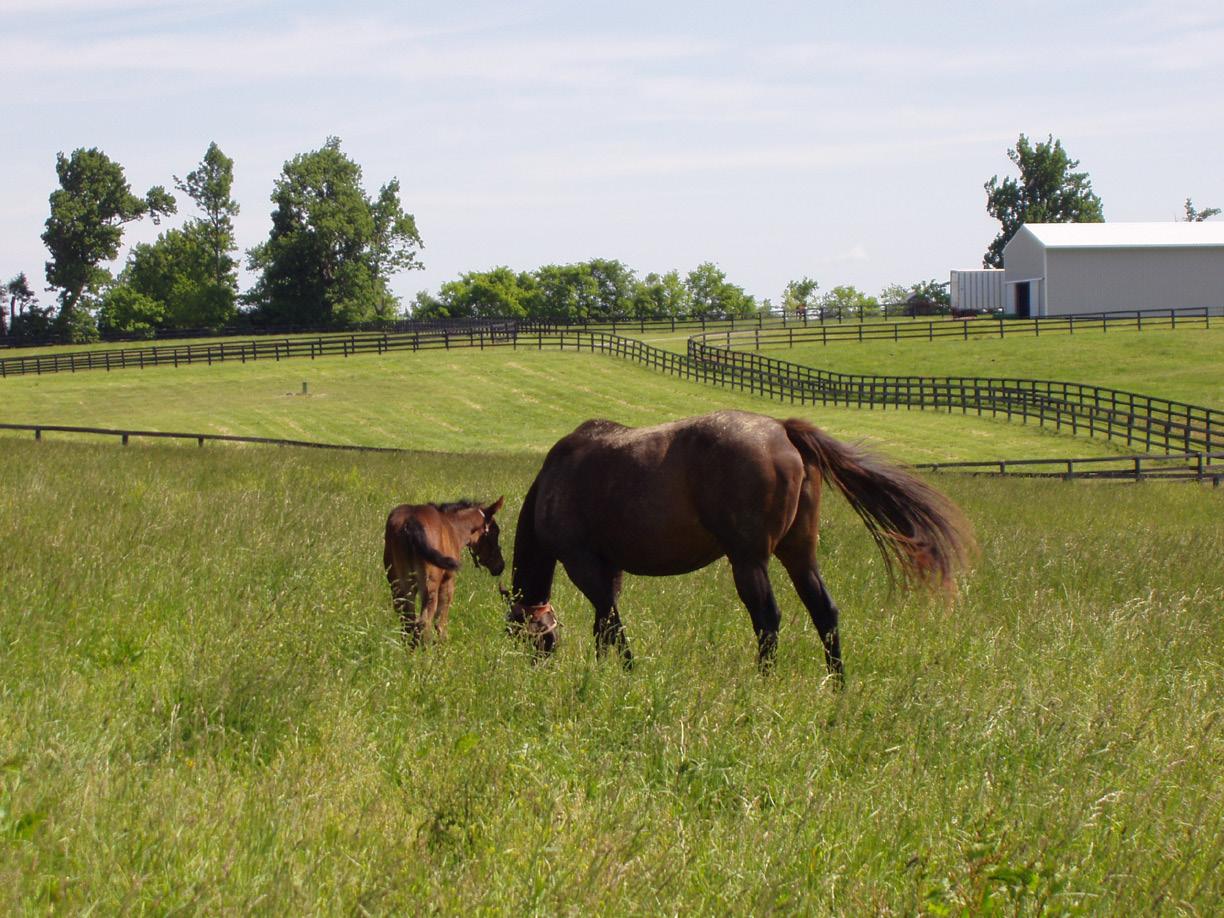
4 minute read
AVOID TALL FESCUE TOXICITY THIS SPRING
Tall fescue is grown on an estimated 35 million acres across the United States. In Kentucky, it can make up at least 20% of any given pasture. While most often a safe grass for consumption, it can bring hazards. Equine fescue toxicosis is caused when pregnant mares eat tall fescue infected with an endophyte fungus, Epichloë coenophialum. Consumption of the endophyte-infected fescue can have effects on mares and foals. “Fescue itself is not a problem for horses,” said Krista Lea, MS, research analyst in the University of Kentucky’s Department of Plant and Soil Sciences and coordinator for the UK Horse Pasture Evaluation Program. “The problem is that most fescue naturally occurring in Kentucky, and throughout the Southeastern United States, is infected with an endophyte which can produce compounds toxic to horses and other livestock. The most common of these is ergovaline.” The grass is a cool-season, perennial bunchgrass brought to North America in the late 1800s from Europe. Since the detection of a field in Eastern Kentucky in 1931, and the ensuing release of the Kentucky-31 variety 12 years later, fescue has become the predominant cool-season perennial grass in the Southeast Studies have shown toxicity symptoms appear in pregnant mares at ergovaline levels greater than 300 parts per billion. However, most UK extension publications suggest a more conservative level of 150 to 200 ppb. During the last trimester of pregnancy, researchers generally advise managers remove mares from endophyte-infected pastures to prevent serious difficulties. Fortunately, fescue toxicity
PHOTO COURTESY UK COLLEGE OF AGRICULTURE, FOOD AND ENVIRONMENT. in other classes of horses (such as geldings and stallions) has been negligible. Clinical signs of tall fescue toxicity in pregnant mares include increased gestation length; agalactia (absence of milk production); foal and mare mortality; tough, thickened or retained placentas; weak and immature foals; reduced serum prolactin levels; and reduced progesterone levels. Other signs include abortions, decreased conception, early embryonic mortality and dystocia. “Getting rid of it on a wide scale is difficult because it’s so well adapted,” said Lea. “Fescue with the endophyte is much tougher and resistant to grazing, drought and pests. Infected tall fescue is really tough and durable in pastures. The best way is to mitigate it or just remove it from individual pastures one at a time. There are some herbicides you can use which will kill the fescue without killing other grasses.” Another alternative is to dilute concentrations of toxic tall fescue in pastures by overseeding other grasses and legumes. Since horses do not prefer tall fescue, having other grasses available significantly lowers the chances for toxicity. Ergovaline concentrations are the highest within the seedheads of the endophyte-infected tall fescue. Strategic mowing of the infected pastures to prevent seed development can lessen the possibility of a spike in toxicity levels. Ergovaline dissipates from the plant after several winter freezes. Ergovaline levels in endoyphyte-infected tall fescue are the highest in the spring. As summertime approaches, grasses slow their rate of growth and ergovaline concentration. On Thoroughbred farms, broodmares are usually in their last trimester during the winter months, therefore the risk for toxicity is much lower in early foaling mares. Lea says that one thing she encourages mare owners to consider is planting novel endophyte tall fescues, such as the Lacefield MaxQ II variety developed by UK College of Agriculture, Food and Environment plant breeder Tim Phillips, PhD, associate professor in Plant and Soil Sciences.
Advertisement

PHOTO COURTESY UK COLLEGE OF AGRICULTURE, FOOD AND ENVIRONMENT. Novel endophyte varieties contain special endophytes that enhance persistence, but do not produce or produce lower levels of ergot alkaloids, making them safe for grazing. Endophyte-free varieties are also safe for grazing, but have poor persistence, especially when forage is overgrazed and under drought conditions. To learn more about the UK Horse Pasture Evaluation Program, visit https://equine.ca.uky. edu/horsepastures. To learn more about fescue toxicity in livestock and how to combat it, visit https:// grasslandrenewal.org/workshops/ to participate in several virtual workshops put on by the Alliance for Grassland Renewal.
| Jordan Strickler is an agricultural communications specialist within UK’s College of Agriculture, Food and Environment.

In this episode Barry Ball, DVM, PhD, Dipl. ACT, Albert G Clay Endowed Chair in Equine Reproduction at Gluck Equine Research Center, Center describes what he and his colleagues have learned about reproductive endocrinology, placental function, feeding broodmares and equine contraception during his time at UK. Ball, who retired this month, also reflects on 35 years of equine reproduction research. The “Equine Innovators” podcast series is brought to you by Zoetis. You can find the Equine Innovators podcast on TheHorse.com, Apple Podcasts, Spotify, Stitcher, Google Podcast, and many other podcast apps. PHOTO COURTESY UK COLLEGE About the Researcher: Ball received his DVM degree from the University of OF AGRICULTURE, FOOD AND Georgia in 1981. He completed a theriogenology residency at the University of ENVIRONMENT. Florida and his graduate training at Cornell University. He was a member of the faculty at Cornell University from 1987 to 1996. In 1996, he was appointed as the first Hughes Endowed Chair in Equine Reproduction at the University of California, Davis. In 2010, he was appointed as the first Clay Endowed Chair in Equine Reproduction at the University of Kentucky. Ball’s research has been directed toward reproductive endocrinology and pregnancy loss in mares. He has received numerous awards, including the SmithKlineBeecham Award for Research Excellence, the Excellence in Equine Research Award from the American Veterinary Medical Association, the Schering-Plough Award for Outstanding Research from the World Equine Veterinary Association, the Norden–Pfizer Distinguished Teacher award from UC Davis and the Theriogenologist of the Year award. Ball was a Fulbright Distinguished Scholar at the University of Cambridge 2004-2005. He is a past chair of the International Equine Reproduction Symposium Committee, and he is a past president of the ACT.




